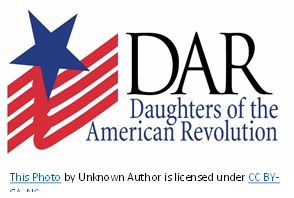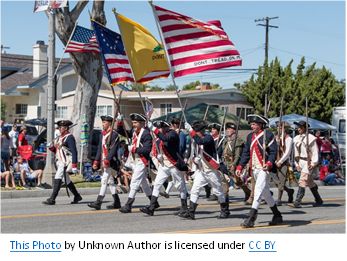Sons and Daughters of the American Revolution – A Genealogical Perspective
 1
1May
Many people have heard of the Sons of the American Revolution (SAR) and the Daughters of the American Revolution (DAR). Some would say there is a certain fascination with these societies. The SAR and the DAR are lineage societies which people can join when they have proven their relationship to a soldier, or to someone who had participated in or supported American independence. Obtaining membership can be difficult because of the strict requirements for proving the applicant’s lineage. The experienced researchers at Price Genealogy can help. Membership applications, and sometimes the historic documents, are kept on file for both societies. Whether your intent is to join, or only to take advantage of their useful research resources, these societies can be a great benefit to genealogical work.
Motivations for membership
Many society applicants join out of patriotic feeling, a desire to connect to history, or a desire to promote these feelings within their community. Membership provides benefits such as: “being able to contribute to important service projects, participate in unique social and service-oriented programs within your community, gain valuable leadership experience, and establish a network of contacts in your community and all over the world.”[1] Applicants also seek membership as a way to verify their lineage and preserve a copy of that work with a reputable society. For some it gives the feeling of honoring one’s ancestors. Another of the genealogical benefits to applying for membership is that it motivates the applicant to gather historical documents to prove a long-believed family story. These newly discovered historical documents, that the applicant will find in the course of research, will add interesting details to their family tree.

Application to the DAR or SAR
To qualify, the applicant’s ancestor must have been a veteran or supporter during the Revolutionary War. They must have served between the period of the 19 April 1775 and 26 November 1783. The applicant for SAR must be male; females will join the DAR. Ancestors do not necessarily need to be soldiers during the war in order to qualify. The following persons also may qualify: signers of the Declaration of Independence, members of one of the Continental Congresses, and those who rendered material aid. Essentially applying for the DAR or SAR is a similar process.
The application consists of a multi-page form available online which asks the applicant to include information about themselves and each generation of their family up to the patriot ancestor. Documents proving each kinship link must be attached. The applicant will apply to the chapter in which he currently lives. For example, if the applicant lives in Ohio, then he would apply to the SAR Ohio Chapter. The applicant will need to find a sponsor to vouch for him, someone who is already a SAR member. Often, the local chapter representative is willing to meet interested persons and to become their sponsor. Contact information is available for these persons online under, “Find Local Society Points of Contact” at SAR.org.[2] The SAR applicant’s sponsor may be able to advise the applicant on completing their application to acceptable standards. Some sponsors may be willing to assist with basic research, but this should not be expected. The research required to submit a successful application is often difficult. The official SAR website cautions those who wish to apply: “Please note that family tradition in regard to the services of an ancestor will not be considered proof.”[3] This is often the point where applicants choose to hire a genealogist such as those at Price Genealogy. Our experts can do anything from focusing on proving specific generations, documenting military service, or we can help you through the entire application process.
Patriot databases and research

The SAR and DAR offer online patriot databases. The DAR provides an ancestors’ search, as well as a descendants’ search. Although the DAR is generally more comprehensive in its patriot database, it is important to search for any Revolutionary War ancestor in each. On SAR.org, they have the “SAR Patriot Research System,” which specifically includes some patriots through whom lineage society applications were never submitted. The applicant should keep the following two warnings from the DAR database in mind which may appear as they click on the links for their ancestors: “This listing does not constitute proof of lineage,” and “…the DAR assigns a single standard surname that covers variant spellings of similar surnames... This spelling system ensures that patriots are not established under more than one spelling.”
Record copies are available for purchase, but even the free index material can be very useful. On occasion, when the applicant searches for an ancestor, they may get a message that says, “FUTURE APPLICANTS MUST PROVE CORRECT SERVICE.”[4] This suggests the old application being viewed did not provide enough evidence to meet the lineage society’s modern standards of proof.
Typical genealogy research techniques will need to be used to prove every generation from the applicant to their Revolutionary War ancestor. This tends to be relatively straightforward in the United States to approximately 1850. This is the earliest census to list every member of a household by name. Of course, there will be exceptions when even this period after 1850 will be difficult for various reasons. Prior to this time, useful records might include church records, land records, probate records, journals, or family Bibles. If others have applied under a particular patriot before, the collections of the SAR or DAR may have what is needed to prove one or more generations of the new applicant’s lineage. Accessing these records will help discover unknown cousins as well. Consider collaborating with them. Watch the Price Genealogy blog for a planned article that discusses Revolutionary War records in general. Understanding how to use those records will help the applicant obtain the evidence he needs of his ancestor’s involvement in the war.
Additional resources
Go to SAR.org or DAR.org for more information. It would be helpful to start a free online account with both, peruse the websites to become familiar with the different research options, and consider joining. There are several pages about their library and genealogical services.
In addition to online resources, the SAR has a library in Louisville, Kentucky, and the DAR’s library is in Washington, D.C. Before going to a library or archive you should always view the catalog from home to plan what you will look at while you are there. The SAR, and the DAR have online catalogs. If you have discovered materials that may assist other researchers, consider donating them to one of the two libraries.
Conclusion
Lineage societies can be a great benefit to those researching their genealogy. While the SAR and DAR were the focus here, but much of the information would apply to other lineage societies as well. Whether a person wishes to join one of these lineage societies or not, everyone can benefit from doing research on the websites of the SAR and DAR. Those who do complete the application process not only discover more about their ancestry in the process, but they leave behind their application and supporting documents for future researchers. Anyone needing help in such an endeavor can rely on Price Genealogy.
Michael and James
[1] Daughters of the American Revolution (https://www.dar.org/national-society/become-member/why-join).
[2] Sons of the American Revolution (https://www.sar.org/meet-sar/become-a-member/find-your-chapter).
[3] https://sar.org/become-a-member/membership-process/are-you-eligible
[4] http://services.dar.org/public/dar_research/search_adb/help-code.cfm?l=1&c=FAMPCS&P_ID=A026439&s=3212
